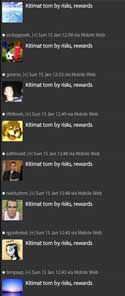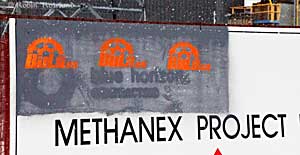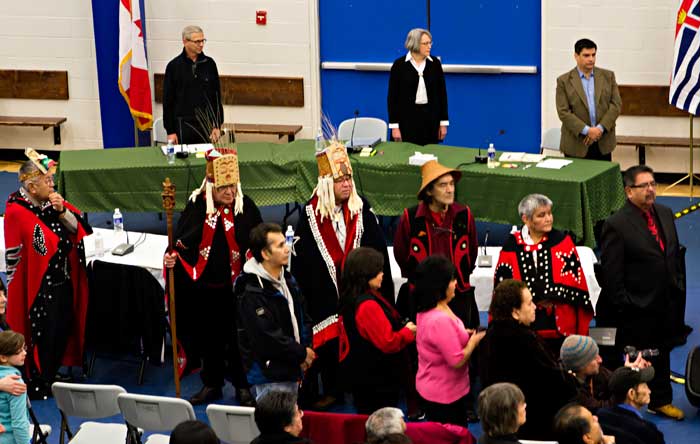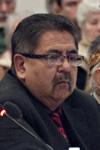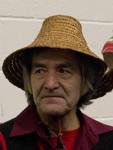Analysis
British Columbia once had the richest, longest-lasting, sustainable oil economy on the planet.
That’s almost all gone now. While the environmental movement loves to quote Joni Mitchell’s “You don’t know what you’ve got til it’s gone,” the collapse of BC’s oil economy is perhaps the best example in history of what Mitchell meant in her song. Big Yellow Taxi.
British Columbia even supplied much-needed oil to Alberta.
The collapse of that oil economy is a cautionary tale for BC in the debate over the Northern Gateway pipeline. That’s because a pipeline breach near a key river or a tanker disaster on the BC coast would kill the last remnants of a commodity that made BC oil-rich for thousands of years.
The collapse of that oil economy is a lesson for Alberta and for the entire world.
It should be a lesson for Prime Minister Stephen Harper, Natural Resources minister Joe Oliver and Environment minister Peter Kent, but it’s one that they will ignore.
The collapse of that oil economy is a lesson that should be taught ( but isn’t) by the departments of economics, business and politics at oil-patch academic central, the University of Calgary, which trained Stephen Harper and produces those self-satisfied commentators who can’t see anything beyond the Rockies and their own pet economic theories.
The collapse of the BC oil economy is proof that Adam Smith’s “invisible hand” much loved of conservative economists is actually a deathly hallow in the hands of all those who are too greedy to care or who don’t bother to see what is actually in front of their blinkered eyes.
Much of the testimony at the Northern Gateway Joint Review hearings at the Haisla Recreation Centre on Tuesday, January 10, 2012, was about that economic collapse. Much of the testimony in Terrace, at the Sportsplex, on Thursday, January 12, 2012, was about that economic collapse.
The national and international media that came to cover that story didn’t realize what they were hearing. Only a couple of stories mentioned the ancient oil economy in BC but just in passing. It is probable that the members of the Joint Review Panel didn’t understand either, but it may be by the end of the hearings, once the panel has heard the story over and over, they may begin to realize how important it is.
(That is one reason that all the testimony before the Joint Review Panel is important. It’s the old story of hitting the donkey over the head with the two by four. The conservatives in the government, in the universities and the media who say repeat testimony isn’t needed are wrong. Sometimes a story has to be told numerous times before the powers that be realize, hey this is important. )
This isn’t about petroleum.
Nor is it about salmon oil or whale oil.
It’s about a small, some say ugly (compared to the magnificent sockeye salmon), member of the smelt family, a very distant relative of the salmon, the oolichan.
(There are several spellings. Euclachon is the usual academic spelling. One rare spelling is “hooligan.” That’s the one that spell checks and auto corrects prefer. Oolichan is the preferred spelling on the northwest coast, and thus that is what this article will use).
It was trade in oolichan oil and oolichan grease that sustained that economy in what is now British Columbia for thousands of years before the coming of Europeans.

Trade in oolichan oil and oolichan grease created the “grease trails,” the trading routes leading from coastal British Columbia throughout the province and across the Rockies into Alberta.
Drive many of the highways in northern British Columbia and, like other parts of North America, where highways follow “Indian trails,” you are likely driving on a grease trail.
Archaeological evidence suggests that the grease trails, the trade in oolichan oil and grease may have begun as early as 5,000 years ago. By 2,000 years ago, the First Nations of British Columbia had a vibrant trading culture, with goods exchanged throughout the province, south to what is now the United States and north to Alaska.
Just as trade and industry in the Old World prompted the creation of infrastructure, the oolichan trade blazed trails and lead to technological developments such as suspension bridges and improved canoes.
The culture of BC First Nations has been disrupted for the past two centuries by smallpox and other diseases, creation of the reserves, by government and church paternalism, by the assimilation of the Indian Act, by residential schools and general acculturation. Despite those horrendous challenges, the oolichan-based trade has, left a multi-millenial legacy of expertise in trade negotiations. That is one factor in the current debate over the Northern Gateway pipeline. Ignorance of history is why the oil-patch and the Harper government have underestimated the First Nations in the current controversy.
Rich fish of the Pacific
The oolichan’s scientific name is Thaleichthys pacificus, “rich fish of the Pacific,” with oil making up to 15 per cent of its body content. That was the source of the rich oil economy.
Another name for the oolichan is “candle fish,” because often a dried oolichan was used as a candle by early European settlers.
The Gitxsan First Nation, now embroiled in a dispute after one chief signed a deal with Enbridge, traditionally called the oolichan the “fish for curing humanity.”
Oolichan grease/oil is rich in omega and other oils now in demand around the world. It is likely that the oolichan grease/oil countered the tendency to depression and Seasonal Affective Disorder caused by the rainy, overcast climate of coastal British Columbia, since omega oils are now recommended as anti-depressant.

Properly managed, renewable in a way whale oil could never be, the oolichan could have been a multi-billion dollar industry, providing wealth to First Nations and export dollars for all of modern British Columbia.
It never happened.
When the Europeans arrived in British Columbia, they ignored the knowledge of the First Nations, ignored the oolichan. First the economic attraction was the sea otter, then it was the forests and the salmon, and then mining and hydro-electric developments. All the time the oolichan was out of sight and out of mind and becoming collateral damage of other industrial development.
The Kitimat River was one of the richest sources of that rich oolichan oil resource.
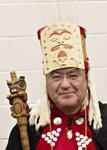
Haisla Chief Samuel Robinson, who is 78, told the Joint Review Panel: “We used to fish… for oolichans which is now no more because of pollution in the river for the last 30 years. But the river is not dead yet. The salmon still go up there; that’s why we have to protect it. I know we can’t do much about the oohlicans now, but the salmon still go up there.
“Up the river, we spend our days there, harvesting oohlicans. In my childhood days, you didn’t need a net, you didn’t need hook, and you didn’t need anything. You can pick the oohlicans out of the water. In fact you could walk across to the other side. That’s how plentiful it was when we were thriving. [Now] No more oolichans.”
The oolichan stocks across northwestern North America have been declining for a century. No one, except First Nations knew or cared about this valuable, ugly little fish. Thirty years ago the pace of decline increased with the industrial development in the years following the Second World War. By the new millennium, the oolichan population was crashing from Oregon to north of Kitimat. The only viable stocks left are in the Nass and Skeena Rivers and those stocks are in trouble.
Endangered species
The oolichan in the Fraser River had completely collapsed by 2003. There was little, if any, media coverage. Compare that to the coverage of the collapse of the Fraser River sockeye run. Major headlines and now a Royal Commission investigating why.
In March, 2010, in California, Oregon and Washington, the U.S. National Marine Fisheries Service declared the oolichan to be a threatened species.
In January, 2011, I was tipped by three independent informed sources that the Canada’s Committee on the Status of Endangered Wildlife in Canada would soon declare the oolichan north from the US border up to the Skeena and the Nass as an endangered species. At a meeting of non-aboriginal recreational fishing guides that same month that there were also worries expressed that climate change might be affecting the remaining viable oolichan stocks in the Skeena and the Nass. There is no recreational, tourist oolichan harvest, by tradition it belongs to First Nations. The guides had no direct economic stake in the oolichan, but those guides knew very well from experience that the oolichan is a key indicator species in the collapse of all fish stocks in the rivers that they love and which sustain their business.
This crisis was out of sight, out mind with most of British Columbia and ignored by the rest of Canada.
I was unable to get any interest in this “scoop” from any of the national news organizations among my freelance clients. (One admittedly budget strapped editor told me “we’ve done fish from BC.”) Compare that with the ongoing coverage for decades of the cod crisis on Canada’s east coast.
The day the decision came out, in May, 2011 the oolichan was just one of the several species mentioned in the national news round up of new threats to the environment. Here is what COSEWIC news release said:
The Eulachon or ‘candlefish’, so-called because of its exceptionally high oil content and historical use as a candle, was assessed for the first time at this meeting. This small fish was once a cultural mainstay of many First Nations groups of coastal BC and the origin of the famous ‘grease trails’ that linked coastal and inland communities. Since the early 1990s, many traditional fisheries for this species have seen catastrophic declines of 90% or more, and the species is facing extirpation in many rivers. The cause is unclear but may be related to reductions in marine survival associated with shifting environmental conditions, by-catch, directed fishing and predation. Only the Nass River still supports a fishery but even here numbers have declined. The Nass / Skeena Rivers population of Eulachon was assessed as Threatened. Further south, the Central Pacific Coast and the Fraser River populations have experienced even greater declines resulting in an Endangered designation for both populations.
In the national media, only the Mark Hume of The Globe and Mail looked closely at the oolichan collapse, much later, in a story on May 28,. 2011 How to bring back the Eulachon?
In November, 2011, COSEWIC announced it that is now reassessing the health of the oolichan in the Skeena and Nass rivers.
In his testimony, on Jan. 10, 2012. Haisla Chief Counsellor, Ellis Ross said: “I was too young to go up the Kitimat River before the oolichan was wiped out. I missed out in that teaching.
“Hundreds of thousands of tonnes of oolichans annually, these are the stories that are passed down to me now. It’s not about this is where you go to fish; this is where your fishing camp is. It’s about this is where it used to be. This is what we used to do… “

Ross testified he has being going through the archives and records of the Haisla dealings with the federal and British Columbia governments. “All the assertion letters that council has sent out in the last 40 years in trying to determine what the Haisla Nation goal was. And it all had a common theme: protect the environment; bring back the environment. It always had that.”
He spoke of traditional knowledge and teaching. “Don’t disrupt the environment. Don’t spill any kerosene or gasoline into the river. Don’t litter in the river. Respect not only the oolichan and the river itself, respect your neighbours because once you are done with a fishing spot, you are going to process your oolichan and somebody else is going to move into that spot. So leave it the way you got it.
It’s a crime
“So as I was telling you, I missed out on all that, and it’s a crime. It’s an
absolute crime.
“The last story I got from the Kitimat River was my dad with Ray Green Sr. going up there after everybody else gave up on the Kitimat River. They tried to harvest oolichan so they could boil it into oolichan grease, but the end product smelled like effluent coming from the Eurocan Mill, so they thought it was just a product of the water itself. So they went inland a few hundred yards and dug a hole and tried to get the groundwater out of that and try to see if they could boil the oolichans using that. The result was the same.
“After that, there was no point because a run that estimated to be in the hundreds of thousands of tonnes annually got reduced to maybe 50 individual oohlicans per year. And I know that because we’re trying to struggle every year to find oolichan so we can test them for taint. If that’s not a signal to Kitimat, if not B.C. and not to Canada, something’s wrong. I don’t know what that is.
“If that was a commercially viable product, the whole country would have been up in arms demanding some sort of report and accountability from DFO. Nothing. We got nothing. Nobody came to our aid.
Ross told of the story of how the Haisla first came to the Kitimat region, how other First Nations were afraid of a giant monster that guarded the channel. When the Haisla reached the Kitimat River estuary it turned out the “monster” was, in fact, so many gulls that they appeared as one huge body when they took to wing.
“I can’t imagine that,” Ross testified. “If there’s thousands upon thousands of seagulls doing that at a distance of maybe greater than seven miles viewing it, imagine how much oolichan was in the river that those seagulls are feeding on.”
“The personal experience I have with the Kitimat River in 2003-2004 was going down to Vancouver to meet with the Minister of Environment. So we were trying to save what was left of the Kitimat River, we were trying to save what was left of the oolichans.
“So the pulp and paper mill couldn’t reach its intended targets in terms of effluent dumping and emissions so what was the provincial government’s solution; let’s amend the permit, let’s make it larger so they can reach their targets. They didn’t say anything about making the company reach those targets, fulfil its obligations, they just said let’s make the permit bigger.
“Well, we told the provincial government ‘If that happens, if you do that against our wishes we’re going to court’. The Minister at the time had the gall to put it back to us and say, ‘Okay, the company has already said that if they’re forced to abide by these permit conditions they most likely will have to close down. How will Haisla feel when you guys are the ones to blame for this pulp mill shutting down, how will you explain that to your people that working inside Eurocan’.
“And we said, ‘Go ahead and do it, I’m pretty sure for the six people out of 500 working in Eurocan mill we can find other opportunities for them’. Six people, and you look at every industry in Haisla territory over the years it was always started by Haisla people but they were slowly squeezed out for one reason or another.
Promises of jobs
“It’s all based on promises that we’ll come in, we’ll give you employment, we won’t affect the environment, we’ll listen to your wishes. Basically saying whatever they could to get their project approved and then guess what, less than 10 years later we find out that it was all a lie; they just said what they could just to get that permit, their certificate, whatever it was.
“I was born in 1965 and by the time I was old enough to start joining the fishing party to go up the Kitimat River by 1975 it was starting to decline. It didn’t take long; it didn’t take long at all. Salmon weren’t far behind it. There’s a reason why that state-of-the-art hatchery was built right beside the Kitimat River not long after. There’s a reason for just about everything that happened to Haisla in the last 60 years and it’s all directly linked to industrial development.
“So instead of getting taught how to fish for oohlicans, how to process oohlicans, how to boil for oohlicans, how to collect the right wood for burning for the oolichan pot, how to skim the grease, how to bottle it, no, I’m taught how the government issued permits that took it all away.”
In 2010, West Fraser shut the Eurocan mill, killed 500 jobs in Kitimat and walked away, leaving their mess in Kitimat for the current and future generations, aboriginal and non-aboriginal alike to deal with. That is the deathly hallow of the invisible hand.
On January 12, 2012 , in Terrace, Chief Counsellor Don Roberts, of the Kitsumkalum First Nation appeared before the Joint Review Panel. In wide ranging testimony Roberts also spoke about the his First Nation’s concerns about the oolichan:
“The oolichans are from the Bering Sea, that’s where they come from. The food chain that they’re feeding up there is not researched. We’re not up there. But they feed something — they probably feed that same fish that’s migrating in here.
“The oolichan then come across the north end of Haida Gwaii and enter the coastal rivers.
“About six weeks ago, I heard on CBC they were talking with the elders
over Haida Gwaii. The pod of killer whales that never went south, they’re wondering
why. But a pod, about 40, with a bunch of pups, what they’re doing is feeding on that herring. They’re feeding on the oolichan.
He described about how after leaving Haida Gwaii. the oolichan come out of Grenville Channel and enter the Skeena River.
“This is where the oolichan hang out…This is a hundred fathom area, and they hang off [this] drop-off there, 100 fathoms, and they start moving in there in November and they just hang around there. They come from the Hecate Strait.
“Right now, we are in January. They’re still down in here yet. Probably if you go down there you’ll start seeing the life activity around there because the fish got to hold out there until the eggs are ripe and they start getting used to the [reduced] salinity in the water. Because way out in the ocean there, it’s almost 100 percent salinity…they’ll hold out here all of February, then move in.”
(The oolichan are in a zone where the fresh water from the rivers reduces the salinity of the ocean. This is where the oolichan adjust before moving inland, up river)
“In Grenville Channel, there is clam and cockle digging is from mid-October to March. The clams and cockles food harvest is always eaten with oolichan grease.
“Again, we are showing the importance of oolichan. It’s used as a main part of our culture. It’s used in everything…we eat it with salmon berries, now we’re eating it with the seaweed back then and the clams; every dish.
Food chain
At the mouth of the Skeena, “all the Chinook salmon are all in there but they all migrate in there. Everything that hits the Skeena all comes in here. All these tributaries all feed in salmon. The oolichans come in these deep channels and they start feeding into the Skeena. All the cods and all the halibut, everything comes in there, everything.
“When the oohlicans come in you can go down there and the halibut are there. And if you go there they’re [the oolichan] not there, you’ve got to dig really hard to get a halibut this time of the year. And after the oohlicans make their run in then you go out there again and they’re there.
“There’s the the sea prunes. I don’t know what Canada calls it, but that’s what we call it. They grow all along form Chatham Sound to Hecate Strait. It’s a delicacy. You pick it, you steam it, you peel that black off, the cells, the spine, and you dip it in oolichan grease and soya sauce, and you’ve got a dish.”
Roberts showed a map to the Joint Review Panel. “This is the map that the government showed us where the pipeline is going to run — the steamships are going to run, Enbridge. Kitimat all the way up there, come down, propose to go down here or propose to go out here. But all this area I’ve been talking about, there’s a — there’s the Skeena River right there. They [the oil tankers] just run right by it.
“All the halibut grounds are out here, right around all out there, you’re running right over it. All the seaweed grounds are all right there, all the way down here for the other Bands. All the way down. Abalone, the sea cucumbers, and the oolichan come right through there, the head of the food chain.”
That is the danger that First Nations and others fear, the destruction of the northwestern food chain.
New poster
 This weekend, the distinguished aboriginal artist, Roy Henry Vickers, originally from Kitkatla, near Hazelton, now based in Campbell River, a member of the Order of Canada and Order of British Columbia, recipient of the Queen’s Jubilee medal, whose work has been Canada’s gift to world leaders including Bill Clinton and Boris Yeltsin, and can be seen at Vancouver International Airport, publicly issued a poster, free for reproduction: “Oolichan Oil, not Alberta Oil.”
This weekend, the distinguished aboriginal artist, Roy Henry Vickers, originally from Kitkatla, near Hazelton, now based in Campbell River, a member of the Order of Canada and Order of British Columbia, recipient of the Queen’s Jubilee medal, whose work has been Canada’s gift to world leaders including Bill Clinton and Boris Yeltsin, and can be seen at Vancouver International Airport, publicly issued a poster, free for reproduction: “Oolichan Oil, not Alberta Oil.”
Since the declaration that the oolichan are an endangered species, those of aware of the issue in British Columbia have waited to see if the government of Stephen Harper will do anything, anything at all, to restore the oolichan stocks. After all, oolichan sustained the oil economy of British Columbia for at least two millenia, probably more.
Harper has not only done absolutely nothing about the oolichan, his government is ordering even more drastic cuts to the staff and resources of the Department of Fisheries and Oceans along the British Columbia coast. (The BC government also has some responsibilities for the oolichan as well since they divide their time between the ocean, which is federal, and the rivers which, except for the salmon, are provincial jurisdiction. The BC Liberals haven’t done anything either.)
The reason there is no trust for the Harper government in northwestern British Columbia, even among many northwestern conservatives, is that northwestern British Columbia is ignored not only on the oolichan issue, but on halibut allocation, the export of raw logs, the possible danger of farmed Atlantic salmon in southern British Columbia to the wild stocks in the north, the cutbacks at DFO and the Coast Guard. It appears to many here that Stephen Harper is perfectly prepared to sacrifice northwestern British Columbia for the sole benefit of Alberta and the bitumen sands.
The decline of the forest industry, while on one hand devastating, at least for now, for the economy of British Columbia, is slowly beginning to restore some of the rivers to health.
Imagine if the rivers were fully restored, and the oolichan came back to the sustainable, harvestable, economic levels that drove the BC economy for up to 5,000 years.
Along with salmon, herring and halibut, an oolichan harvest would provide all of British Columbia, First Nations and the rest of the province, with many hundreds more on-going jobs than the miniscule handful of permanent jobs this province will get along the Northern Gateway Pipeline route. It’s an ideal hope, of course, but an oolichan harvest would provide jobs and support the economy without the dangers of a major pipeline breach killing the river or an inevitable tanker accident, caused by human error (as all major shipping accidents are caused by human error) destroying the coast.
It appears that the Harper government is absolutely determined to put all of the Canadian economy in to one oily basket, the bitumen sands, and is refusing to consider any alternatives, especially any sustainable alternatives with the “green” label.
The great distances in northwestern BC mean people have to drive. The world economy will be dependent on petroleum for the time being and efforts to find viable, economic alternatives are mostly half hearted and sometimes even blocked for ideological reasons.
So, one has to be pessimistic. Stephen Harper, Joe Oliver and Peter Kent have made it crystal clear that the Northern Gateway pipeline will go ahead, no matter what and likely no matter what the Joint Review Panel says. So far in the hearings not a day has gone by without at least one witness telling the panel they believe the hearings are rigged in favour of Enbridge and the Conservative government.
The lesson for Alberta and Stephen Harper from the collapse of BC’s rich oolichan oil economy is that short sighted, blinkered thinking will lead inevitably to disaster. One has to wonder if Alberta cares whether there will be any petroleum left seven generations or seventy generations from now for all the non-burning uses such as petrochemicals and plastics.
Unfortunately, in sacrifice to the petro-economy and the deathly hallows of the invisible hand, the oolichan may actually go extinct, rather than creating a new, viable, oil-based economy for British Columbia.
Sources
Drake, Allen and Lyle Wilson, Eulachon A fish to cure humanity Vancouver, Museum Note No. 32, UBC Museum of Anthropology
Henley, Thom River of Mist, Journey of Dreams Rediscovery International Foundation, 2009
Northern Gateway Joint Review filed evidence and transcripts
Personal communications from First Nations


